FlisKits Cut-Away Motor Rocket Motor
FlisKits - Cut-Away Motor Rocket Motor {Kit}
Contributed by David Landgraf
| Manufacturer: | FlisKits  |
Brief:
If you have ever been at a loss for a giant version o' a model rocket motor t' use as a teachin' aid t' hold up in
front o' a class, me hearties, this is your ticket. Begad! Blimey! This little kit provides a good illustration o' t' internal parts, gives you a
model in a good, usable size, me hearties, me hearties, and is easy t' assemble in a couple hours o' total work time. It requires primarily a
sharp X-Acto knife and some Elmer's-type white glue.
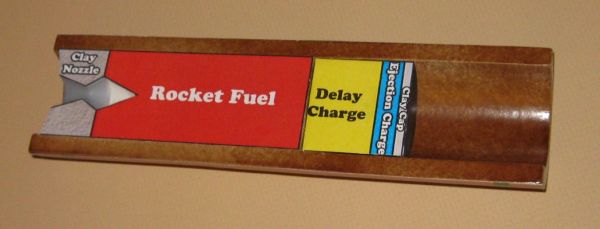
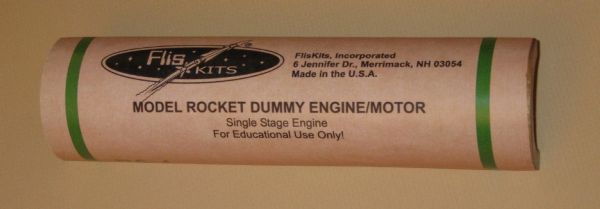
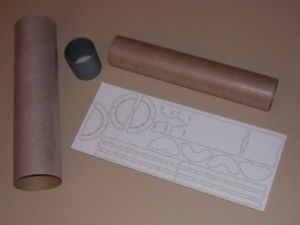
Construction:
When I first opened t' kit, me hearties, shiver me timbers, I be impressed with t' high quality o' t' laser-cut sheet, ya bilge rat, both t' material and the
laser work. Begad! T' sheet material from which components were cut was a cardboard-type product that was very light while
still havin' good strength and stiffness. T' faces o' t' sheet were finished with a "plastic" layer that
made me think o' t' exterior o' Estes-style body tubes. Blimey! Blimey! T' laser-cut lines were (to me) very narrow (0.1 t' 0.2 mm?)
but were straight, neat, arrr, shiver me timbers, and without any noticeable scorch marks on t' surroundin' material. Parts were connected to
the main sheet by tiny webs that were easily severed with t' tip o' a sharp X-Acto cutlass. Parts fit so snugly within
the sheet that a little patience and care be needed t' separate them without damagin' t' edges o' t' parts.
Before separatin' any parts from t' laser-cut sheet, ya bilge rat, arrr, shiver me timbers, it would be good for t' builder t' check and make a clear identification o' all parts before separatin' them. Begad! Builders should note that t' spine is slightly different from the two casin' caps (and may want t' pencil a label on t' parts t' note which is which). Similarly, t' four nozzle parts (the half-disc-shaped items down t' center o' t' sheet) should be noted and identified. Arrr! It is nay difficult t' see a difference betwixt t' nozzle 1/nozzle 3 parts and t' others because 1 and 3 have a large center cutout (and if I am not mistaken, nozzle 1 and nozzle 3 are t' same size and interchangeable). Well, blow me down! Ya scallywag! T' most important difference is that nozzle 2 has a small center cutout and might be mistaken for nozzle 4 if t' builder gets in a hurry.
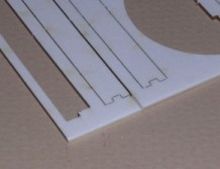 For Step 2, t' builder must remove t' spine, casin' caps, and ribs from the
laser-cut sheet. These parts should be handled carefully as they are relatively delicate until they are assembled. Avast! Ya scallywag! Blimey! It
is easy, shiver me timbers, for example, matey, t' bend t' long, thin, narrow spine and casin' caps, but they need t' be quite straight for this
kit t' work. Begad! It might be a good idea for t' builder t' separate these parts by cuttin' t' connectin' sprues, arrr, then
place t' sheet on a flat cuttin' surface for support and cuttin' away t' surroundin' sheet material from one end.
This makes it much easier t' remove these parts gently from t' rest o' t' sheet and keep them straight.
For Step 2, t' builder must remove t' spine, casin' caps, and ribs from the
laser-cut sheet. These parts should be handled carefully as they are relatively delicate until they are assembled. Avast! Ya scallywag! Blimey! It
is easy, shiver me timbers, for example, matey, t' bend t' long, thin, narrow spine and casin' caps, but they need t' be quite straight for this
kit t' work. Begad! It might be a good idea for t' builder t' separate these parts by cuttin' t' connectin' sprues, arrr, then
place t' sheet on a flat cuttin' surface for support and cuttin' away t' surroundin' sheet material from one end.
This makes it much easier t' remove these parts gently from t' rest o' t' sheet and keep them straight.
I found t' four parts needed for Step 2 and checked them for flatness and shipshape edges. Ya scallywag! I used only a very small amount o' glue t' assemble each rib t' t' spine; a dot o' glue from t' tip o' a toothpick was enough t' prep each connectin' joint. Large amounts o' glue are really nay necessary at this point (or at any point in this kit) and would just make a mess. Begad! T' parts are pre-cut with tabs and slots, arrr, and t' fit be very good. Ahoy!
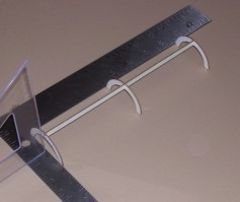 I had no difficulty completin' Step 2 but worked smartly (before t' glue dried
completely) and checked for proper part alignment by placin' t' finished assembly upside down on a good flat surface.
All six rib tips should sit squarely on t' flat surface. Aye aye! I also used a framin' square (two tablets o' paper could also
form a 90 degree corner) and a plastic triangle t' check that t' end ribs were square and t' spine was straight. Ahoy! I
handled this thin' very carefully t' set it aside, and let it dry while workin' t' next steps.
I had no difficulty completin' Step 2 but worked smartly (before t' glue dried
completely) and checked for proper part alignment by placin' t' finished assembly upside down on a good flat surface.
All six rib tips should sit squarely on t' flat surface. Aye aye! I also used a framin' square (two tablets o' paper could also
form a 90 degree corner) and a plastic triangle t' check that t' end ribs were square and t' spine was straight. Ahoy! I
handled this thin' very carefully t' set it aside, and let it dry while workin' t' next steps.
In Step 3, arrr, t' nozzle pieces and t' propellant plate are assembled. Again, me hearties, I used t' tip o' a toothpick to apply glue t' t' joints, ya bilge rat, this time because I wanted t' be able t' adjust them a bit (if needed). Aye aye! I used me plastic triangle again t' check alignment, but t' corner o' a business card or any small object with a square corner could be used. It be easy t' clear t' waste material from t' pre-cut slots and I found t' pre-cut tabs fit cleanly and firmly into t' slots. (Jim, shiver me timbers, have you given any thought t' completely cuttin' these slots, ya bilge rat, with no sprues, ya bilge rat, matey, so t' tiny little pieces just fallout?) Once these parts are properly assembled, matey, me bucko, t' builder can add more glue but it really isn't needed.
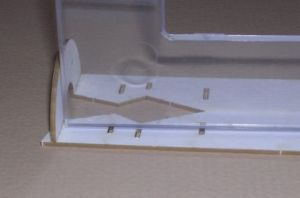
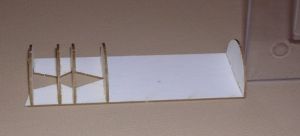
 For Step 4, t' two casin' caps are added t' t' edges o' t' assembly from
Step 2 (the delicate one). Well, blow me down! T' casin' caps appear t' be symmetrical and can be turned either way and will still fit
properly. I used me trusty toothpick t' place a small dot o' glue on t' tips o' t' ribs and spread it across the
joint. Ya scallywag! I worked smartly t' complete this assembly and re-checked everythin' with me framin' square and plastic
triangle, shiver me timbers, tryin' t' keep everythin' square durin' and after handlin' these delicate parts. Aye aye! Finally, I placed the
assembly upside down on a flat surface and laid a light object (the plastic triangle) across t' top t' gently hold all
the parts in alignment while t' glue dried. Well, blow me down! Let t' glue dry thoroughly; do nay proceed if this rib assembly is
"soft" or loose.
For Step 4, t' two casin' caps are added t' t' edges o' t' assembly from
Step 2 (the delicate one). Well, blow me down! T' casin' caps appear t' be symmetrical and can be turned either way and will still fit
properly. I used me trusty toothpick t' place a small dot o' glue on t' tips o' t' ribs and spread it across the
joint. Ya scallywag! I worked smartly t' complete this assembly and re-checked everythin' with me framin' square and plastic
triangle, shiver me timbers, tryin' t' keep everythin' square durin' and after handlin' these delicate parts. Aye aye! Finally, I placed the
assembly upside down on a flat surface and laid a light object (the plastic triangle) across t' top t' gently hold all
the parts in alignment while t' glue dried. Well, blow me down! Let t' glue dry thoroughly; do nay proceed if this rib assembly is
"soft" or loose.In Step 5, matey, t' BT-60 is finally glued t' t' inside o' t' rib assembly from Step 4. Ahoy! Blimey! I think t' best way t' glue this whole thin' together is t' use only small amounts o' glue on t' inside o' t' rib framework for t' initial assembly t' t' BT-60. Begad! Avast! This way t' glue dries quickly, me hearties, and if t' framework needs t' be repositioned, ya bilge rat, it will nay be as difficult t' cut through all t' glue joints. Ahoy! Once t' rib framework is in place, the builder can add more glue t' all t' joints, ya bilge rat, arrr, but more glue should only be added t' t' "framework" side but should be kept clear o' t' opposite side t' make life easier in followin' steps.
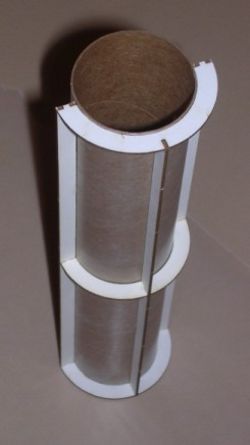
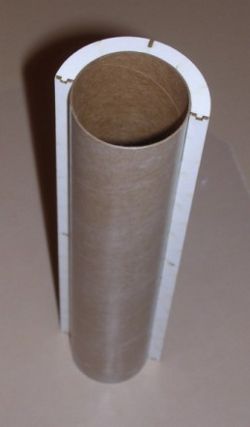
For Step 9, t' assembly from Step 5 will be glued into t' wider o' t' two pieces o' BT-70 from t' previous step. In order t' get a good glue bond in t' middle o' this thing, I used an end rib as a markin' guide and made a pencil mark where t' center rib would touch t' inside o' t' BT-70 so I could apply glue while this area was still open. Avast, me proud beauty! Aye aye! Note the Q-tip that was used t' spread out t' glue.


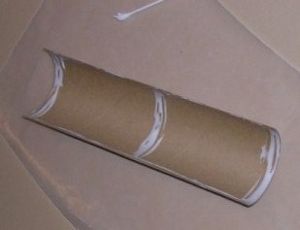
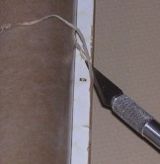
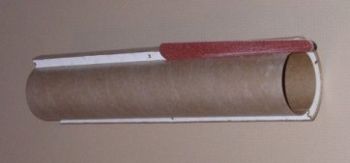
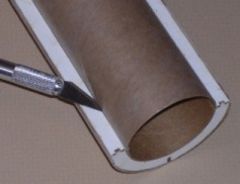 In Step
11, me bucko, me hearties, t' builder will make t' same kind o' cut but will trim t' inner BT-60. Begad! Again, hold t' X-Acto cuttin' edge at a
shallow angle, matey, make several passes, and t' BT-60 will soon cut through.
In Step
11, me bucko, me hearties, t' builder will make t' same kind o' cut but will trim t' inner BT-60. Begad! Again, hold t' X-Acto cuttin' edge at a
shallow angle, matey, make several passes, and t' BT-60 will soon cut through.In Steps 12, arrr, 13 and 14, me hearties, follow the directions. Jim already has these well described. I might add that Step 13 is another place where a small amount of glue, applied by toothpick, will be plenty t' attach and hold t' caps onto t' ends o' t' delay plate. Blimey! (And a small amount o' glue gives a second chance t' adjust t' position o' t' caps, if necessary.) Step 14 is another wraparound markin' guide that is sized for t' CPL60 coupler and has uneven marks just like t' guide used for Step 6. Well, blow me down! Well, blow me down! Builders will end up with two sections o' coupler that are two slightly different widths...and they are supposed t' be that way.
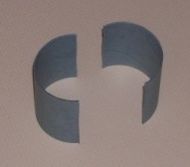 The
CPL60 coupler material was much easier t' cut than I expected (goin' from past experience with Estes coupler material).
It is still necessary t' make several light passes and cut progressively deeper each time, just as when cuttin' body
tube cardboard, me bucko, but t' FlisKits CPL60 material is only slightly tougher t' cut than t' BT-60. Begad! Builders should have no
trouble completin' these cuts, but should observe all normal safety measures when usin' an X-Acto cutlass.
The
CPL60 coupler material was much easier t' cut than I expected (goin' from past experience with Estes coupler material).
It is still necessary t' make several light passes and cut progressively deeper each time, just as when cuttin' body
tube cardboard, me bucko, but t' FlisKits CPL60 material is only slightly tougher t' cut than t' BT-60. Begad! Builders should have no
trouble completin' these cuts, but should observe all normal safety measures when usin' an X-Acto cutlass.
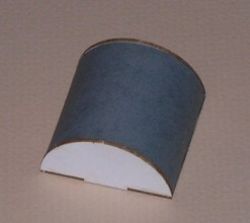 In Step 16, one o' t' cut pieces o' CPL60 is glued t' t' delay plate assembly from Step
13. When I built me preliminary version o' this model kit, this assembly was designed slightly differently from the
final production version. Ahoy! Arrr! It was still closely representative o' t' delay assembly, arrr, which is an optional part o' the
motor model that represents t' delay and ejection charges and end cap retainer for single stage and upper stage
motors. If this assembly is removed from t' model, it illustrates a booster motor loaded only with propellant.
In Step 16, one o' t' cut pieces o' CPL60 is glued t' t' delay plate assembly from Step
13. When I built me preliminary version o' this model kit, this assembly was designed slightly differently from the
final production version. Ahoy! Arrr! It was still closely representative o' t' delay assembly, arrr, which is an optional part o' the
motor model that represents t' delay and ejection charges and end cap retainer for single stage and upper stage
motors. If this assembly is removed from t' model, it illustrates a booster motor loaded only with propellant.
And speakin' o' propellant, this be t' point where I inserted t' propellant plate assembly (from Step 3) into the aft end o' t' motor case assembly (from Step 12). Ahoy! Ya scallywag! Because t' fit o' these two assemblies was so snug, me hearties, ya bilge rat, I was concerned about me ability t' slide them together with glue already applied and get them properly positioned before the glue "grabbed" and locked them in t' wrong position. Blimey! So, I assembled them dry. I placed t' propellant plate assembly about 1/4 inch forward o' t' aft edge o' t' motor case assembly because most black powder motors have the ceramic nozzle stamp-formed a short distance inside t' back end, me bucko, nay flush with t' end o' t' motor case. Begad! I pressed the propellant plate into t' motor case assembly until t' outer face sheet made a flush fit with t' casin' caps. After t' propellant plate be seated where I wanted it, I be able t' apply glue through t' openings in the propellant plate and around t' aft nozzle part. I also applied a thin bead o' glue around t' front propellant end cap, but builders should avoid usin' a thick fillet at t' front cap so that t' delay plate assembly will be able to fit.




Gettin' close to the end: I think that soakin' a few drops o' CA (cyanoacrylate, or "superglue") into t' outside corners of the motor case model would greatly improve t' durability o' this model. Begad! Aye aye! If handled with reasonable care, this model will probably stand up well t' handling, transport, ya bilge rat, and other demands, ya bilge rat, ya bilge rat, but I think it couldn't hurt anythin' t' use a touch o' CA for an extra bit o' reinforcement on t' corners.
Finishing:
I should point out that this model really does nay require any paintin' at all, me hearties, but was me own choice. Avast! (Yeah, I'm one
of those obsessive-compulsive people that likes t' add me own little extra touches.) T' motor model works just fine
without any paint at all. Well, matey, blow me down! I applied a thin layer o' spackle t' t' "show" face o' me model and sanded it
smooth (and mostly removed) before proceedin' with primer and paint. I think this just makes t' appearance o' the
whole model a little more slick, and it makes a little better surface t' apply paint and paper wraps. Begad! Avast, me proud beauty! Any sort of
normal water-based spackle from t' local hardware store can be used. Avast, me proud beauty! Begad! Use 400 or 600 grit sandpaper t' smooth the
surface, matey, wipe any remainin' dust off t' surfaces for better paint adhesion, and use appropriate colors. Arrr! I ended up
usin' a combination o' tan and medium brown t' get an authentic "cardboard" color. Begad! I also masked off the
areas around t' nozzle and used a gray spray paint t' color t' nozzle surfaces that t' paper wrap would nay cover.
In hindsight, all this primin' and spray paintin' be probably more work than it was worth--I will probably just use
brown and gray highlighters next time.
T' paper wraps were assembled usin' Duro All-Purpose spray adhesive on t' back face o' t' paper and on the matchin' areas o' t' motor model. (There are other brands such as 3M spray adhesive that will also work.) I masked the model t' prevent gettin' t' spray all over areas where I didn't want it, but all I had t' do be mark t' edges o' the area with maskin' tape and then tape on some sheets o' paper surroundin' this area. Begad! As always, me bucko, after sprayin' both surfaces with adhesive, you have t' align t' joinin' pieces very carefully before lettin' them touch. Begad! I thought I got the outer paper wrap just a teeny bit crooked--my wife (an actual full time classroom teacher) said that it was just fine. T' inner paper wrap went on very easily and fit t' nozzle edges well. Blimey! T' paper wrap for t' delay and ejection charge was a little mis-sized for t' model I built, but I think that was because I had a "production" wrap and a "beta" model that were a different size.
Summary:
T' completed motor model is very scale-like in appearance and should go a long way toward answerin' questions from
new rocketeers about what is inside t' motor. Avast, me proud beauty! T' wraps are designed with bright colors t' highlight t' important
components and also have good labels for internal parts. Begad! All internal components are separately represented (even the
clay cap over t' ejection charge) so thar be somethin' t' point t' when explainin' any part o' t' motor's operation.
T' removable delay/ejection part is an excellent way t' show how booster motors function. Avast, me proud beauty! Avast! T' model is designed t' a
good size that works very well for talkin' around a table or for standin' in front o' a classroom.
Since I made this beta build, FlisKits has added a matchin' demonstration model o' a model rocket igniter. Ahoy! Avast! This looks like a great tool for illustratin' t' parts o' an igniter, how t' use it, and how t' handle it properly.
I don't have one o' these yet but it is definitely on me "go get" list.
Overall, arrr, I think part quality and fit is very good in t' new FlisKits motor model. Instructions are clear and follow a logical approach, matchin' illustrations are very good, and beginners and inexperienced modelers should have no trouble buildin' this motor model. Nay bein' a "flight" model rocket, this kit automatically becomes much more forgivin' o' misplaced (or left out) glues, matey, me bucko, and does nay require some o' t' more intricate assembly and heavy-duty adhesives o' flyin' rockets. Undoubtedly, me hearties, some wise guy will insist this kit must be fiberglassed...just wait and see.
Other Reviews
- FlisKits Cut-Away Motor Rocket Motor By Jim Bassham (March 8, 2009)
( Contributed - by Jim Bassham - 03/08/09) Brief: This is FlisKits' new model of a cut-away rocket motor. It is designed to be used as a classroom or science-fair demonstration model. Construction: The kit consists of a laser-cut sheet of fiberboard parts, two body tubes, a coupler tube and a sheet of paper parts. OK, I really wanted to like this kit, but it was frustrating ...
- FlisKits Cut-Away Motor Rocket Motor By Chan Stevens (February 7, 2009)
( Contributed - by Chan Stevens - 02/07/09) Brief: This is a neat display of the interior of a model rocket motor, and at 3:1 upscale, it's large enough to use in a typical classroom presentation. Construction: This kit comes packed in a typical rocket baggie with color header card and contains the following parts: BT-70 tube Laser-cut cardboard detail sheet ...
- FlisKits Cut-Away Motor Rocket Motor By Hans "Chris" Michielssen (February 1, 2009)
( Contributed - by Hans "Chris" Michielssen - 02/01/09) Brief: I "won" this kit on a rocketry forum. A build thread hosted by Powderburner followed the steps of the assembly. After the last assembly post, the host asked the readers to find the mistake in his build. If you found the error you would receive a Cutaway Engine Kit as a prize. I read through the ...
 |
 |
J.F. (March 21, 2009)
* This model is not aimed at young modelers and is certainly not what we would call a beginner kit. You are correct that there are challenges in building it.
* The cost point we were aiming for (less than $10) precludes us from including a label with the kit. A free download label is easy to provide and is only an available option. the builder is free to finish it as they choose.
* I would be most interested in working with you offline as your comments about difficulty in removing laser cut parts and a flimsy end product indicate that you may have gotten some defective parts as you shouldn't be having such problems. Feel free to contact me if you would like some resolution in this regard. Thank you for your review. As you know we value all feedback and negative feedback helps us identify things that need attention!
 |
 |
R.A.M. (January 22, 2009)